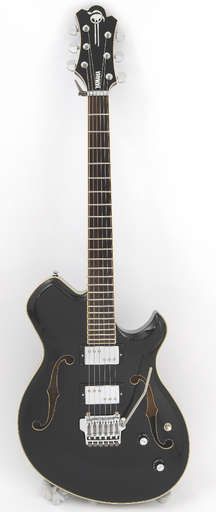There are many unusual features included within the spec of the guitar, not least the innovative Takumi-Kezuri body. The phrase translates from the Japanese as 'skilful carving', which is a suitable description of the techniques required to carve the back, sides and centre block of this semi from one single block of wood (alder in this case).
Although the lion's share of the R&D took place at Yamaha's Hollywood custom shop facility, the Takumi-Kezuri procedure is carried out by luthiers based at Yamaha Hamamatsu in the Land Of The Rising Sun.
The body is topped of by a two-piece, hand-carved maple top that is bound in cream and, to fit in with the semi-acoustic vibe, bears a pair of f-holes.
Wes Boland from Limp Biscuit has always used Yamaha's and his style does require an efficient double-locking whammy but, instead of a standard Floyd Rose unit, Yamaha has designed what it calls a Finger Clamp Quick Change Tremolo system.
The main innovation is the locking nut that's tightened and loosened via a side-mounted finger wrench. There's no need to remove the ball ends from the strings, which are fed through the body and bridge, and once locked in place a familiar array of fine tuners keep everything secure.
At its fullest rear depression it gives seven frets' worth of travel and can take all kinds of bounces, bombs and whinnies. The pickups here - a pair of Custom33 split-field humbuckers - represent the first time that Yamaha has included custom-built units on a production guitar.
Again designed to Borland's specs in Hollywood, each is controlled by its own volume pot and selected via three-way toggle.
If you like your guitars with a bit of fight, you'll enjoy getting to grips with the hefty three-piece maple neck.
Although measuring a typical 43mm at the nut, it widens considerably as you go towards the 24th fret and, with the very low action offered by our example, you can thrash away, execute endless outrageous bends or try some of Borland's tricks without the maple ever restricting your style.
Sounds
To our ears the pickups seem more vintage-voiced than anything else and, with the resonant body design and huge maple neck, there's plenty of tone on offer: if you can imagine a hot-rodded Thinline Gibson semi through a fat old Marshall, you're in the ballpark.
Chords are equally open and round, or trashy and bright depending on your amp settings and, from clean styles to out-and-out rock, the CV820 holds its own assuredly.
The bridge is extremely sensitive to any pressure; even resting your hand on it while playing causes proceedings to drift out of tune.
In fact Wes told our sister mag Total Guitar that he actually tunes a cent or two below 440Hz as a matter of course to counteract this characteristic. Still, the vibrato works very well indeed, even if the protruding nut clamp does take some getting used to in terms of its position.
There is an inherent risk with buying any signature guitar, as you do have to spend time getting used to that particular player's idiosyncrasies and specification choices.
That said, don't dismiss them out of hand, as it's always worth trying something different. Mention tremolo antics and you think of Steve Vai, and although this guitar hardly resembles an Ibanez JEM, the two have more in common than you'd think: pickups with a smooth voicing, an outrageously efficient vibrato and a unique look.
Take it from us: there's no such thing as a bad Yamaha guitar and although the low action, bare fingerboard and vibrato of the CV820 WB will require some sitting with, the build quality here is easily up to the asking price.
The Finger Clamp system is a little on the fiddly side, but then so is any double-locking vibrato and at least you won't need to hunt for a pesky 3mm Allen key just to tune or restring.
£1,299 is a brawny sum for anyone to spend on a guitar, especially one that's sold without a case, so consider your purchase carefully, but here you can be sure of a good range of tones and a look that will set you apart.

